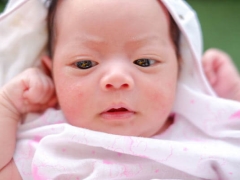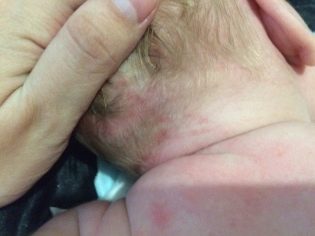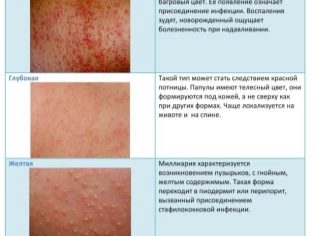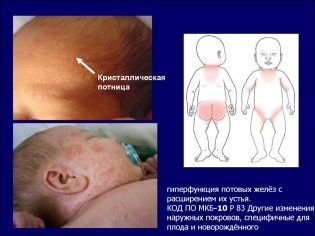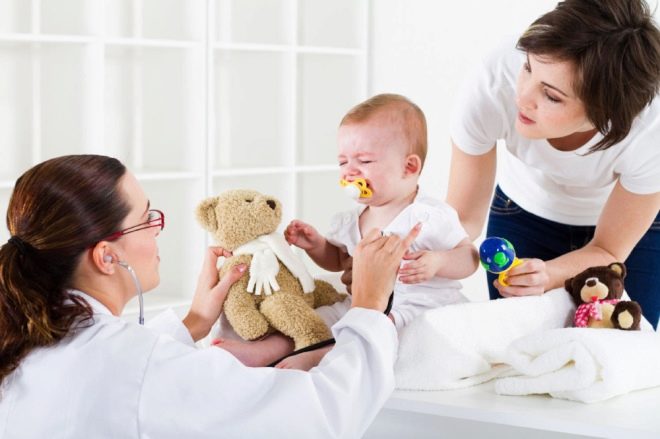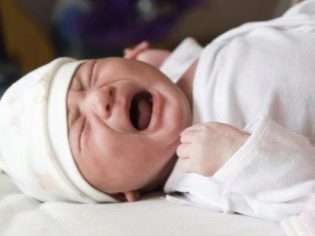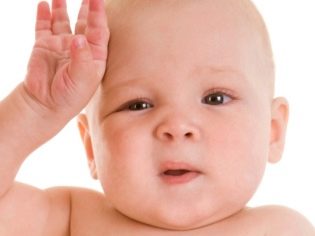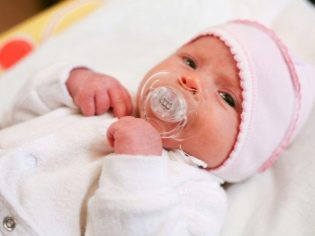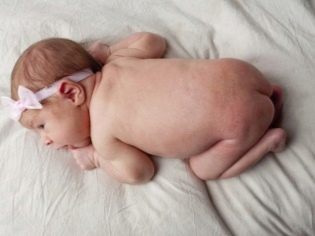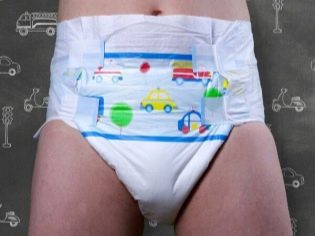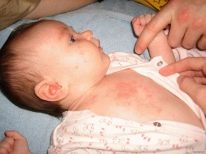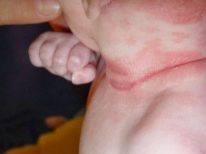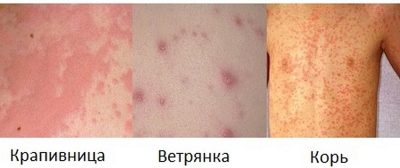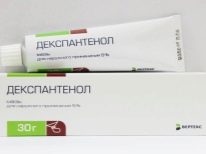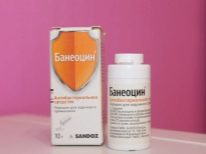Symptoms and treatment of prickly heat in children
Prickly heat in children occurs at any time of the year, but in summer, when it is hot outside, its manifestations can be especially intense. Sore bite is quite painful and gives to the tot the noticeable discomfort. It is widespread in childhood, and therefore it is difficult to find someone who has never suffered from hemorrhage in childhood. About how it manifests itself and how to help the child, we will tell in this material.
Definition
Prickly heat is one of the most common types of dermatological problems that are frequent in childhood. It is manifested by a rash on the skin. So violently gentle and thin skin of babies reacts to the violation of the ratio of the processes of separation of sweat and its evaporation.
Glands that produce sweat, are formed in the period of intrauterine development. They begin to function almost immediately after birth. Small children are less sweaty, but at school age the glands begin to work more intensively, reaching a peak of activity during puberty.
Increased secretion would not be a big problem for the body of your child, if the sweat had a place to evaporate. If this possibility exists, no rash is formed. But if evaporation is difficult, an aggressive, salty sweat environment causes local skin irritation. The stronger and longer the aggressive effect, the greater the irritation.
Children of absolutely all ages can face this problem. However, more often than others at any time of the year (but more often in the summer) infants suffer infants. The skin of newborns, its individual layers are arranged in such a way that they are initially several times thinner than the skin of adults or older children. At the same time, the center of thermoregulation in the cerebral cortex of the newly born into the world does not function as it should. Therefore, newborns can overcool or overheat faster.
The ducts of sweat-secreting glands in babies are narrow. They have yet to form. Usually this process ends by 4-5 years. And while the process is underway, prickly heat is more than likely in 1 year and 2-3 years. Through the narrowed ducts, a large amount of sweat can not depart in time, a strong heat loss is possible with the development of inflammatory processes in the ducts and glands themselves.
In this case, the disease develops - blockage of the ducts. If at this stage not to take measures and not to help the baby, diaper rash will begin. Their depth and area of damage can be significant. But even small diaper rash are dangerous for the child primarily because they are a hospitable "entrance gate" for the bacteria that surround us practically everywhere.
Bacterial inflammation of the skin is more severe and may be complicated by a systemic bacterial infection. To prevent this from happening, parents must respond in time to the signs of heat loss and treat it properly.
Views - what does it look like?
There are several types of children's prickly heat, they differ in the type of rash, the duration of the pathological effects of sweat, the degree of miliarity. With any of these views, parents may well face.It should be understood that the specific name of the prickly heat type does little to resolve the issue of treatment - in almost all varieties of the ailment, the therapy is almost identical.
We will tell about it below, but for now let's understand what kind of prickly heat struck your baby.
- Crystalline. The classic version, the easiest and quite innocuous. Small blisters appear in places exposed to sweat and are not accompanied by signs of inflammation or infection. Small bubbles are most often noticeable in the growth zone of hair on the head, on the neck, behind the ears, but other places of location are very likely. Crystalline miliary disease often occurs in children after a disease that has a high fever. After a day's temperature, this small and medium-sized rash can already appear.
- Red With this type of prickly heat, it can be assumed that the destructive effect of sweat on the sensitive skin of a child was longer. The rash is red, around the small inflamed elevations (in the area of the ducts) the skin swells a little. Separate elevations are tubercles, they do not merge with each other, they are clearly distinguishable.
- White When a miliary disease with the same name bubbles on the skin contain whitish or slightly yellowish liquid. If such a bubble bursts, a light “patina” remains in its place. This prickly heat scratches and gives the baby inconvenience.
- Deep With most miliary disease, the inflammation is superficial. And only with a deep lesion occurs in the deeper layers of the skin. Blisters appear on baby’s skin with light content. They quickly burst or spontaneously dissolve. After that, on the spot of the blister, nothing at all imperceptibly.
Any type of prickly heat can become complicated and turn into diaper rash or an infected form of miliaria. In case of diaper rash, the inflammation is deep and rather diffuse in area of damage. Quite often, the skin that inflames sweat is inflamed. Diaper rash is often represented by moist and very painful eczema.
Infected miliary disease occurs when pathogenic bacteria or fungal flora enter affected skin (for any type of damage listed above).
Most often, in childhood, hemorrhage is diagnosed, complicated by joining staphylococcus. Complicated prickly heat looks like an inflammatory lesion with pustules.
Clinical picture
The main symptom is simple and obvious: the toddler has a rash. Most often it can be seen in the folds, as well as on the head, on the back and chest, under the arm or in the groin, between the buttocks. On the priest, on the back and on the stomach, signs of local irritation usually appear in children whose parents practice tight swaddling.
Other symptoms may not be. It all depends on the temperament of the child, on the degree of milaria, on his individual sensitivity. Some children calmly tolerate the situation, while others demonstrate a full range of children's “sufferings” - impaired appetite, whims and unstable sleep. When you touch the affected area of the skin, the child feels pain, itching, discomfort.
Infected species of prickly heat manifest themselves in a clearer clinical picture:
- temperature rises (up to 37.0-37.8 degrees);
- on the affected skin appears light bloom, bleeding cracks, ulcers;
- general condition worsens.
When assessing symptoms, it is important for parents to understand that they can cope with the majority of cases with miliaria on their own, without resorting to the help of doctors.
However, eczema, diaper rash and infected miliaria require a mandatory consultation with a pediatrician or pediatric dermatologist, since the treatment will differ from the usual scheme just as different as the bacteria that can affect the skin, fungi, or the depth of earth damage.
Causes
To understand why prickly heat appeared to the baby, you need to know that sweat is released not just like that, but in order to cool the body when it is overheated. If the child is hot, the sweat glands work more intensively, the sweat is formed many times more. It gets on the skin and evaporates, giving to the environment some of the excess body heat for the child.
But we already know that the ducts of the sweat glands of children are narrow, and abundant flow leads to blockage. Inflammation begins. Sweat that falls on the inflamed areas from the adjacent ducts, which are still passable for the liquid, leads to the deterioration of the condition of the former.
What factors can cause such pathological processes:
- non-compliance with the temperature regime (it is hot in the room);
- wrong choice of clothes (the child is cramped or too hot);
- uncomfortable shoes (tight shoes or sandals made from "not breathing" materials cause inflammation on the legs, on the feet, between the toes);
- excessive use of cosmetics and skin cleansers (an acid imbalance occurs, the skin becomes more vulnerable, and even a small blockage of several ducts can lead to extensive and deep heat loss);
- violation of the rules of hygiene (rare change of the diaper, inadequate care of the child);
- viral and other diseases (at high temperatures, the body is forced to "give" excess heat to prevent the development of hyperthermia).
Complaints of prickly heat to doctors are most often addressed by parents of children who are confused, protected from any drafts, as well as children who are bathed every day with soap. Children with allergies (with local manifestations), chubby children with overweight or obesity, and babies with congenital or acquired diabetes are at the risk group for the highest susceptibility to miliary disease. More often than others, prickly heat develops in children with rickets, frequent diarrhea, seborrheic dermatitis.
Chicken rash "plagues" premature crumbs and babies, for whatever reason, deprived of breast milk and being artificially fed.
There are also reasons that can be safely attributed to the category of common parental errors and misses:
- the use of fat creams and products (“Children's Cream”, oils used for massage, if used very often, cause mechanical forced closure of ducts and the development of miliary disease);
- the use of warming lotions and compresses (wraps, cans, and other methods of warming up, for example, with a cold, often cause excessive sweating in a certain area of the skin, which is intense thermal effects);
- things of synthetic and semi-synthetic fabric (in it the skin is not able to ensure the normal evaporation of sweat);
- poor quality diaper, not suitable for size.
The most important thing to remember is that a child, who is dressed for the weather, who grows up in an apartment where parents monitor the required air temperature, will rarely suffer from chickens, in particular, and other ailments related to the violation of heat exchange in general.
Difference from allergies and other diseases
The biggest problem that parents face is the complexity of the differential diagnosis of prickly heat and allergies. Indeed, sometimes it is quite difficult to understand, because of what appeared a rash - because of overheating or because of complementary foods, which mom treated the toddler the day before. And it is necessary to find out.
Look at the child carefully. Miliaria is often "based" where the separation of sweat can be difficult - skin folds, hair, the area under the diaper, the place of contact (friction) of clothing, shoes, diapers.
On open and “ventilated” areas of the skin, prickly heat practically does not occur. While allergy does not select a location, it can manifest itself absolutely on any part of the body.
Thus, if the baby woke up with a reddish rash on the face, on the forehead, on the arms (the open part), on the legs (not on the feet), then with a high degree of probability it is about an allergic reaction to something. Rash and redness on the pope or on the shoulders (if swaddling is used) - this is miliaria.
But what if the rash appeared on the body where it can theoretically occur with allergies and prickly heat? Do a simple home test. It is called air. Uncover a child with a suspicious rash, and leave it alone for a few hours. Without clothes and a diaper, with constant access of air, prickly heat passes quickly, after a couple of hours the inflammation decreases. If the rash is allergic in nature, no visible changes will occur to them.
From chickenpox, measles and other viral diseases that also cause a rash, prickly heat differs in the number of symptoms. When miliary disease rash on the skin - almost the only sign. When infectious diseases increase the temperature, symptoms of intoxication appear, the rash will spread very quickly through the body.
Call a doctor at home should be suspected of an infectious disease, go to him for an appointment - with suspected allergies. It also makes sense to invite a pediatric doctor for a newborn with any rash. If the child is not even a month old, it is not recommended to do the diagnosis yourself at home. This is the task of specialists.
If it is impossible to distinguish, you should call a doctor, this is especially important when it comes to the appearance of a rash in a newborn - a child from birth to 28 days.
Therapy - General Rules
It is completely easy to get rid of prickly heat, it is important only to follow the basic rules of treatment of this unpleasant illness. In all cases, if there is no talk about chickpea complicated by infections in infants, treatment is allowed at home. This means that proper care will fall entirely on the shoulders of parents or other relatives.
For a start, parents will have to reconsider their attitude to the concept of "heat". Comfortable and optimal air temperature in the room should not exceed 21-22 degrees. Humidity in the nursery should not deviate from the basic parameters of 50-70%. Such a climate may seem too cold.
Do not trust your adult perception - you have a different thermoregulation. Child's skin and baby's immunity as a whole will benefit just such a climate.
This means that in winter you should lower the temperature of the heating, it will not hurt to buy a humidifier that will maintain the desired humidity. If prickly heat happened in the summer, again you need to check whether the microclimate parameters in your apartment correspond to the indicated norm. If not, then ventilate, moisten, and there will be no trace of prickly heat in a couple of days.
Pay attention to how the child is dressed. All synthetic and semi-synthetic items should be removed from the children's wardrobe, replacing them with clothing made from natural fabrics. Try not to confuse the baby. This applies to his stay in the house, and walks on the street. He will sweat if there are more clothes than the situation requires. If the child is very small, buy him vests and sliders that are sewn outwards to eliminate friction and aggravation of miliarium.
Do not be afraid to leave your baby without clothes more often. Air baths have not hurt anyone. This is an effective “recipe” for chilli and an excellent way to increase immunity. Bathing should be a daily procedure, keep skin clean, but refuse regular use of detergents - foams and gels, soaps, even if the packaging says that the product is child-friendly and hypoallergenic.
With prickly heat, sunbathing is also useful for a child - sunbathe at the cottage in some shorts, feel free to go bathing your baby at sea or in the river.This is also an important element of strengthening immunity, including local, dermal.
You can remove the rash and cure the miliary disease with an ointment or cream approved by a pediatrician. You are required to use them correctly in strict accordance with the attached instructions. All products, which we describe below, should be applied to clean skin.
Preparations for children
The main thing parents should remember is that the remedy for chilli should not have an oily moisturizing base. When applying baby cream, which is so fond of mommies and grandmothers, inflammation will only intensify.
It is treated exclusively with remedies that have a drying effect. Not bad, if the drug has an additional effect and creates a thin protective film on the affected surface.
Help to choose the right drug will help our list:
- «Sudokrem» - agent based on zinc oxide. Dries and protects the affected area on the skin from bacteria and fungi. It has a water repellent base. Absolutely harmless and non-toxic, and therefore must be in the home medicine cabinet of the family in which children of any age are growing up.
- "Chlorophyllipt" - A tool that will help you quickly cope even with significant diaper rash. For children, you should choose the drug in the form of an oil substance or an external spray. Eucalyptus leaf extract promotes rapid healing and resists bacteria. If the baby is prone to allergies, it is used with caution and only after consulting a doctor.
- «Bepanten» - a popular and loved by parents means. Can be used at any age. It contains dexpanthenol and B-group vitamins. The cream quickly heals the dry elements of prickly heat, but it is absolutely contraindicated for moist eczema, as it has a slight moisturizing effect.
- "Zinc ointment" - inexpensive, but very effective means, the composition of which can be guessed by name. Apply a thin layer, while it is necessary to lubricate not only the elements of the rash, but also the adjacent skin to enhance the effect and prevent infection.
- «Dexpanthenol» - means which is issued in the form of gel, cream and external solution. You can choose absolutely any of the pharmacological forms for your baby. They are well tolerated by children of any age.
- "Desitin" - A tool that is useful in the presence of diaper rash and eczema. In addition to zinc oxide, the product contains cod liver oil for the speedy recovery of damaged skin layers. The tool has a powerful drying effect, it is considered not the best choice for the treatment of a child under the age of 12 months.
- "Tsindol" - ointment, which can be ordered at any pharmacy with its own prescription department. It is made to order. The tool belongs to the category of drying, anti-inflammatory, anti-pruritic. For very young children, it is imperative to consult a doctor before use.
All of these drugs will do an excellent job with any form of chickens and even diaper rash. Special special medical skills do not require their use. But if the skin of the baby has already formed pustules and we are talking about complicated miliary disease, then other drugs will be needed. To destroy the bacteria that feel great on the skin with injuries, you need a more powerful "artillery".
In this case, in the first-aid kit it is necessary to keep drugs with antibiotics for external use and other means:
How and from what list to use, the doctor will tell. Parents should remember that all these aniline dyes are strictly prohibited to be applied to the mucous membranes, and when using antibacterial ointments, consider the multiplicity of application and observe the mode of use, not exceeding the dosage.
Try to avoid baby powder if your child has weeping diaper rash or pustules. For other forms of miliary disease, use powder in reasonable quantities, infrequently, to prevent excessive dryness of the skin.
Prevention
To save the baby from prickly heat, a lot is not required. It is important not to overheat the child - do not wear too warm, do not cover with a warm blanket at night, if it is June in the yard. Tight swaddling "soldier" or "column" - an ambiguous question. If there are no special medical recommendations to swaddle the baby in this way, it is better to refuse him. This will reduce the incidence of hemorrhage.
Wear a child in things from natural fabrics, and this wish is relevant even if you have a teenager growing up - during puberty, under the influence of hormones, sweating becomes more intense. In the summer, the child can be bathed up to 2-4 times a day, the main thing is not to use soap with each bath.
Complications can be avoided by the timely reaction of parents to the initial elements of hemorrhage.
Do not disregard them - any manifestation of miliary disease is easier to treat in the initial stage. Sometimes it is enough just to rinse well and treat the affected area of the skin with one of the above mentioned preparations so that the miliary disease stops and disappears.
Reviews
On the Internet there are many informative and useful reviews of mothers who prefer to treat girl with their children. So, good and fast results are obtained by bathing in a bath with the addition of decoction of a string or infusion of bay leaf. You can also use for bathing decoction of chamomile.
Celandine and other herbs that contain substances hazardous to babies should be avoided. These herbs are more suitable for adolescents and children of secondary school age. Moms emphasize that Before using herbs, make sure that the child is not allergic to them. To do this, a small drop of cooked broth or infusion is applied on the back of the palm of the child. If after an hour there does not appear redness or swelling, you can take the fitovnu.
It is important not to overdo it - not every bathing should be done with herbal remedies, and the general course of the phytowatch should not exceed 10 days (when used every 2-3 days).
In order not to confuse the child and put it on correctly, experienced mothers advise to follow the “+1” rule. This means that the child should have as many clothes as you should have, but one more item. It is best to be guided by your own feelings - if you are hot in a light sundress, then it is absolutely merciless to insist that the child should have a second vest.
See the video below for advice from a dermatologist for treating chickens in babies.
